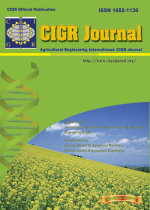Citation:

Abstract:
This paper presents a mathematical modeling of thin layer drying of tomato (Solanum lycopersicum L.). To this end, two different methods are used to dehydrate tomato slices namely the solar drying (in an indirect solar drier), and the forced convective drying (in a convective drier). In the solar drier, the experiments are carried out at a constant air velocity of 1 m s-1and average temperatures of 37.2°C, 39.9°C and 42.5°C. In the convective drier, the experiments are performed with five different temperatures (30°C, 40°C, 50°C, 60°C and 70°C) at a constant air velocity of 1 m s-1. In order to estimate and select the appropriate drying curve equation, fifteen different thin layer mathematical drying models available in the literature are applied to the experimental data. The models are compared using the correlation coefficient (r) and the standard error (s) and are predicted by a non-linear regression analysis using the Curve Expert software. The Midilli-Kucuk model shows a better fit to the experimental drying data according to (r) and (s) for the two drying methods. The effect of the drying temperature on the parameters of this model is also determined. The experimental drying curves show only a falling drying rate period. On average, tomatoes are dried until the moisture content to 0.15 kg water kg-1 dry matter from 14.36 kg water kg-1 dry matter in the solar drying, and to the moisture content of 0.10 kg water kg-1 dry matter from 12.66 kg water kg-1 dry matter in the convective drying.
Keywords: solar drying, convective drying, tomato slices, thin layer, mathematical modeling, curve expert software.
